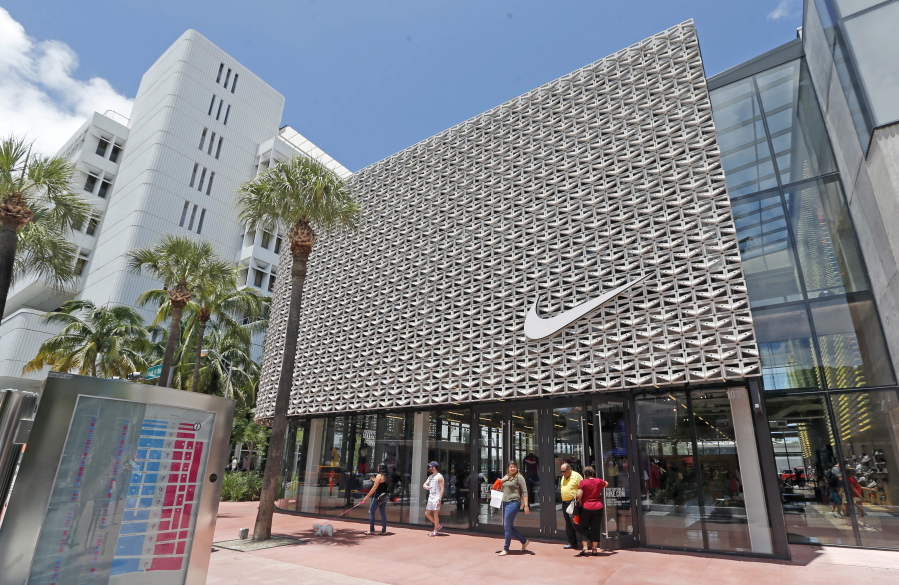With its shares and confidence surging, Nike Inc. was on top of the world in 2015.
The company was at an “all-time high,” Chief Executive Officer Mark Parker said at an investor day in October of that year. He predicted sales would jump 63 percent by 2020 to total $50 billion annually. “It’s clear that Nike is a growth company,” he said.
Two years later, his claim is anything but clear. Increased competition, led by Adidas, has knocked the world’s largest sports brand off course and muddied its outlook. Since Parker made the forecast, Nike’s stock is down 17 percent — erasing $22 billion in market value. Sales growth has been uneven, slowing to just 0.1 percent last quarter.
On Wednesday, Parker and his management team will hold another investor day at the company’s headquarters in Beaverton, Ore. This time, they’re trying to convince Wall Street that the vision is still alive.
“It went from a company with all these tailwinds and firing all cylinders to having headwinds and not firing on close to all cylinders,” said Brian Yarbrough, an analyst for Edward Jones. “They are going to have reset expectations.”
If Parker and his management team are scaling back their aspirations, they’ve shown few signs of it. They’ve told investors that they are changing some aspects of the business — like speeding up sneaker production — and betting that investors will give them time because of their track record.
That record includes a 2010-2015 period in which Nike dominated the U.S. — the company’s largest and oldest market — with average annual sales gains of 10 percent. There were no acquisitions — just organic growth that led to a tripling of the company’s stock price.
But Parker, a Nike lifer who became CEO in 2006, didn’t foresee that the boom in athletic footwear and apparel would fizzle. He also didn’t predict that the rapid growth of sporty attire — what many call “athleisure” — would simultaneously lure a slew of nonathletic brands to the segment.
Fashion houses like Burberry and Jimmy Choo piled in on the high end, while mass retailers like Target started their own lines aimed at shoppers looking for affordable options. Adidas, which had struggled for years in the U.S., also came on strong and managed to close its coolness gap with Nike by focusing on casual looks and pushing partnerships with celebrities like Kanye West.
“2015 was an extraordinary year and really was an outlier in terms of growth rate in apparel and footwear,” Matt Powell, an analyst for NPD Group, said of the U.S. market. “Everybody thought that was going to go on forever, and it didn’t.”
Now that athleisure is slowing amid a flood of competitors, industry fallout has been substantial. Under Armour is the worst-performing stock in the S&P 500 over the past year, with a 56 percent decline. Foot Locker is just behind it, with a 53 percent drop.
“This was a face plant for the industry,” Powell said.
As a result, Parker’s projected $50 billion in sales, which the company had proposed reaching by the fiscal year ending in May 2020, might fall short by $10 billion. At the time, the guidance meant that 10 percent annual growth rates would have to continue. In the two years since then, gains have been about half that. Nike expects to grow at a similar rate this year as U.S. weakness continues.
“They went on a five- or six-year tear that was pretty unbelievable, with eye-popping numbers for a company that big,” Yarbrough said. “But they don’t command the respect they used to and are starting to lose some credibility.”
Nike earlier this year announced its first major layoffs since the financial crisis, cutting about 2 percent of its workforce, or 1,400 employees.
Cracks have even appeared in Nike’s Jordan brand. Since their introduction in the 1980s, the shoes remained a premium product that often sold out in a couple days. This success forged a “sneaker-head” culture that powers a secondary online market and feeds demand for new releases. Their popularity continued unabated even as memories of Michael Jordan started to fade after the NBA superstar retired almost 15 years ago.
Some Jordan shoes are now being discounted because of lackluster demand. Foot Locker CEO Dick Johnson even singled them out as a reason for declining sales during his company’s last earnings call in August.



